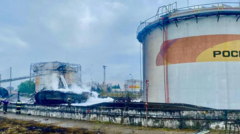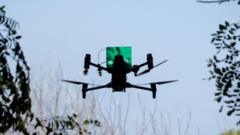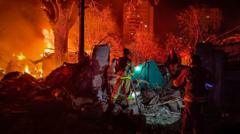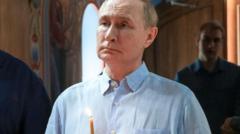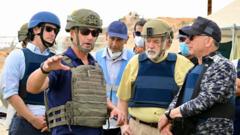As Ukraine's troops withdrew from Kursk last week, soldiers like Artem Kariakin shared the ordeal of their escape from disorganized conditions, emphasizing the urgency of their retreat, while still reflecting on the tactical achievements of their incursions.
Chaos of Withdrawal: Ukrainian Soldiers Describe Retreat from Kursk
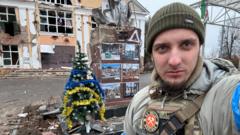
Chaos of Withdrawal: Ukrainian Soldiers Describe Retreat from Kursk
Ukrainian soldiers recount the tumultuous retreat from the Russian-held town of Sudzha amidst fraught communications and ongoing skirmishes.
Artem Kariakin, a soldier involved in the recent withdrawal from the Russian town of Sudzha, provides a vivid account of his unit's experiences just days ahead of their retreat. Having made frequent trips across the Ukrainian border into Sudzha, Artem shows footage from their last mission, portraying burnt-out military remnants littering the road. During their flight, an incoming Russian drone posed an immediate danger, narrowly missing their vehicle as Artem reflected on their luck amidst chaos.
“Not well organized” describes the retreat Artem recalls, citing confusion and late orders as key contributors. Limiting factors like the failure of necessary Starlink satellite communications heightened dangers for their units, forcing some soldiers to abandon their vehicles in haste. Despite recognizing the disarray, Artem sees the offensive as a primary success since it compelled Russian forces to pivot away from eastern fronts, allowing most of Ukraine's troops, albeit many on foot, to escape.
The backdrop to this military maneuver involved ongoing high-profile conversations between US and Russian leaders, a notion that Artem responded to with skepticism. He communicated his disappointment regarding the US approach to the war and the prospect of territorial concessions, feeling as though outside politicians prioritize geopolitics over the lives of Ukrainian citizens and their homeland.
The situation continued to escalate, claiming the involvement of units under Serhiy, who remains undeterred by the complications of initiating cross-border raids targeting Russian military assets. As a native of Russia, Serhiy's perspective compels him to confront threats directly, deploying advanced military vehicles and preparations for nighttime operations aimed at locating damaged equipment close to the frontlines.
Navigating through hazardous terrain marked by previous airstrikes, the challenges for Serhiy’s team exemplify the ongoing volatility of the conflict. He reflects on heightened scrutiny regarding American military support, fearing that potential shifts in political priorities could precipitate a ceasefire detrimental to Ukrainian interests.
Both Artem and Serhiy's narratives illustrate a resilient stance against adversity while contemplating external alliances and the breadth of international backing amid pressing military needs. Their experiences reveal that while the withdrawal was marked by disorder, the resolve to protect their homeland and seek a future of peace remains unaffected, underscoring a complex view of the ongoing conflict.
“Not well organized” describes the retreat Artem recalls, citing confusion and late orders as key contributors. Limiting factors like the failure of necessary Starlink satellite communications heightened dangers for their units, forcing some soldiers to abandon their vehicles in haste. Despite recognizing the disarray, Artem sees the offensive as a primary success since it compelled Russian forces to pivot away from eastern fronts, allowing most of Ukraine's troops, albeit many on foot, to escape.
The backdrop to this military maneuver involved ongoing high-profile conversations between US and Russian leaders, a notion that Artem responded to with skepticism. He communicated his disappointment regarding the US approach to the war and the prospect of territorial concessions, feeling as though outside politicians prioritize geopolitics over the lives of Ukrainian citizens and their homeland.
The situation continued to escalate, claiming the involvement of units under Serhiy, who remains undeterred by the complications of initiating cross-border raids targeting Russian military assets. As a native of Russia, Serhiy's perspective compels him to confront threats directly, deploying advanced military vehicles and preparations for nighttime operations aimed at locating damaged equipment close to the frontlines.
Navigating through hazardous terrain marked by previous airstrikes, the challenges for Serhiy’s team exemplify the ongoing volatility of the conflict. He reflects on heightened scrutiny regarding American military support, fearing that potential shifts in political priorities could precipitate a ceasefire detrimental to Ukrainian interests.
Both Artem and Serhiy's narratives illustrate a resilient stance against adversity while contemplating external alliances and the breadth of international backing amid pressing military needs. Their experiences reveal that while the withdrawal was marked by disorder, the resolve to protect their homeland and seek a future of peace remains unaffected, underscoring a complex view of the ongoing conflict.

